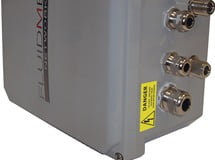ONE of the great
challenges for security integrators and for end users securing large sites and
multiple centralised locations across public and open spaces is managing comms
paths. While in some instances it’s possible to piggyback on existing cabled
infrastructure, where such infrastructure doesn’t exist, the cost of trenching
and side boring makes quality wireless an extremely appealing option.
It’s here that
Fluidmesh Networks comes in. The company is a collaboration between MIT in the
U.S. and Italy’s Mila Politecnico and the company’s technical grounding makes
the Fluidmesh product very solid indeed.
At the heart of
Fluidmesh is a wireless transmission protocol that’s been built to handle video
and critical applications. As part of this focus, Fluidmesh devices
automatically detect the arrival of video packets, identifies their type
(MPEG-4, MPEG-2, H.264, I-Frame, P-Frame) and transport protocol and then
adjusts the wireless transmission to best support each one.
“The EasyMesh
platform lets integrators and users configure wireless solutions as Layer 2
using a single subnet for the whole system or as a Layer 3 network for more
complicated solutions”
According to
Fluidmesh, the company’s technology supports multicast transmission, which
reduces camera bandwidth and load on IP devices like IP cameras, encoders,
access control systems and switches attached to a Fluidmesh port. The EasyMesh
platform lets integrators and users configure wireless solutions as Layer 2
using a single subnet for the whole system or as a Layer 3 network for more
complicated solutions.
Then there’s
another neat Fluidmesh innovation – the melding of EasyMesh with FMQuadro – a
web-based interface that allows users to manage and even configure the system
with no external software. Excellent, too, FMQuadro gives full network status
in graphical form and in real time. There are online warnings of problems like
low signal, high link error rate and network congestion. There’s also an
embedded spectrum analyser that allows scanning of supported network bands for the
optimal channel in a given location.
Fluidmesh 1100
Supporting
Fluidmesh applications are a range of devices, starting with the Fluidmesh 1100
single radio wireless unit is a quadri-band wireless Ethernet product designed
to handle video surveillance and security applications. This little Fluidmesh
1100’s compact size makes it ideal for low visual impact installations
particularly in urban areas.
The 1100 has an
integrated panel antenna for easy installation and the ability to transmit
line-of-sight signals for about 2.5km. An on-board low power PoE injectors
ensures easy installation. A neat feature of Fluidmesh 1100 is FluidThrottle,
which allows users to limit cost by paying only for the amount of bandwidth
that’s required. If more throughput is required it can be achieved with
software plugins. Other features of the Fluidmesh 1100 include FluidMax and
EasyMesh.
Fluidmesh 2200
Duo
The 2200 Duo dual
radio wireless unit is designed specifically for security and video
surveillance applications, the great strength of of 2200 Duo is that it’s able
to transmit the video streams coming from the cameras attached to it and
dynamically route packets coming from other Fluidmesh units via the optical
path.
The Duo 2200
features a pair of quadric-band radios with N-Female connectors that can
operate at 2.4GHz, 4.9GHz and modulate up to 108Mbps. You can use the dual-band
capability to double bandwidth for full duplex links. Duo 2200 incorporates
EasyMesh and FMQuadro, and secures signals with AES-128 encryption support. The
Duo 2200 housing is IP68/NEMA6P – that’s a submersible outdoor enclosure.
Fluidmesh 2200
Endo
The Fluidmesh
2200 Endo is another dual-radio wireless product that designed to be embedded
in custom made outdoor enclosures for special applications. The 2200
incorporates the same hardware and software as the Duo 2200 but in a more
compact unit. This includes a pair of quadri-band radios, EayMesh and FMQuadro.
There’s also
FluidMAX – which can be used to build point-to-point, point-to-multipoint and
Mesh architectures. Fluidmesh also supports the WiMax point-to-multipoint
architecture and its wireless units can operate with a centralised or
distributed medium access control protocol with the appropriate network design.










